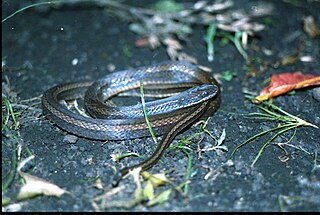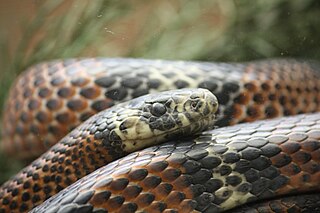
The milk snake or milksnake, is a species of kingsnake; 24 subspecies are currently recognized. Lampropeltis elapsoides, the scarlet kingsnake, was formerly classified as a 25th subspecies, but is now recognized as a distinct species. The subspecies have strikingly different appearances, and many of them have their own common names. Some authorities suggest that this species could be split into several separate species. They are not venomous to humans.

The California kingsnake is a nonvenomous colubrid snake endemic to the western United States and northern Mexico, and is found in a variety of habitats. Due to ease of care and a wide range of color variations, the California kingsnake is one of the most popular snakes in captivity.

Pantherophis obsoletus, also known commonly as the western rat snake, black rat snake, pilot black snake, or simply black snake, is a nonvenomous species of snake in the family Colubridae. The species is native to central North America. There are no subspecies that are recognized as being valid. Its color variations include the Texas rat snake. Along with other snakes of the eastern United States, like the eastern indigo snake and the eastern racer, it is called “black snake”.

Loxocemus bicolor, the sole member of the monotypic family Loxocemidae and commonly known as the Mexican python, Mexican burrowing python and Mexican burrowing snake, is a species of python-like snake found in Mexico and Central America. No subspecies are currently recognized. Analyses of DNA show that Loxocemus is most closely related to the true pythons and the sunbeam snakes.

The common basilisk is a species of lizard in the family Corytophanidae. The species is endemic to Central America and South America, where it is found near rivers and streams in rainforests. It is also known as the Jesus Christ lizard, Jesus lizard, South American Jesus lizard, or lagarto de Jesus Cristo for its ability to run on the surface of water.

The desert kingsnake is a species of kingsnake native to Texas, Arizona, and New Mexico, United States. It is not venomous, colored yellow and black. The desert kingsnake's diet consists of rodents, lizards, and smaller snakes, including rattlesnakes. They normally grow 3–4 ft long, but have been known to grow up to 6.8 ft. They are docile creatures when confronted by humans. If they do not try to escape, often they "play dead" by flipping over onto their backs and lying motionless. Some who domesticate kingsnakes, such as ranchers, do so in the hopes that the kingsnakes will feed on other snakes, which might present more of a threat. It was previously considered a subspecies of the common kingsnake. The desert kingsnake belongs to the Colubridae family, which is the largest family of snakes in the world.

The wildlife of Costa Rica comprises all naturally occurring animals, fungi and plants that reside in this Central American country. Costa Rica supports an enormous variety of wildlife, due in large part to its geographic position between North and South America, its neotropical climate, and its wide variety of habitats. Costa Rica is home to more than 500,000 species, which represent nearly 5% of the species estimated worldwide, making Costa Rica one of the 20 countries with the highest biodiversity in the world. Of these 500,000 species, a little more than 300,000 are insects.

Bothriechis schlegelii, known commonly as the eyelash viper, is a species of venomous pit viper in the family Viperidae. The species is native to Central and South America. Small and arboreal, this species is characterized by a wide array of color variations, as well as the superciliary scales above the eyes. It is the most common of the green palm-pitvipers, and is often present in zoological exhibits. The specific name schlegelii honors Hermann Schlegel, who was a German ornithologist and herpetologist. For other common names see below. No subspecies are currently recognized as being valid.

Lamprophis is a genus of medium-sized, nonvenomous snakes commonly referred to as African house snakes, in the family Lamprophiidae.

Coniophanes is a genus of colubrid snakes, commonly referred to as black-striped snakes, but they also have many other common names. The genus consists of 17 species, and despite the common name, not all of them display striping.

Lampropeltis triangulum campbelli, commonly known as the Pueblan milk snake or Campbell's milk snake, is an egg-laying subspecies of non-venomous colubrid snake. It is commonly bred in captivity and is found in several color variations. When handled, it can discharge a pungent-smelling exudate from its cloaca as a presumed defense mechanism.

Lampropeltis triangulum andesiana, commonly known as the Andean milksnake, is an alpine subspecies of milk snake.

Arizona elegans arenicola, commonly known as the Texas glossy snake, is a subspecies of nonvenomous colubrid snake endemic to North America.

Arizona elegans philipi, commonly known as the Painted Desert glossy snake, is a subspecies of glossy snakes, a nonvenomous colubrid endemic to North America.

Drymobius margaritiferus, commonly known as the speckled racer, is a species of nonvenomous colubrid snake native to the Americas. The specific name, margaritiferus, means "pearl-bearing" in Latin, referring to the pearl-like spots on the dorsal scales.

The azure-hooded jay is a species of bird in the family Corvidae. It is found in Middle America. Its natural habitat is subtropical or tropical moist montane forest. This species is known to have four subspecies. It is 11 to 12 inches in length and is dark blue with a black head and upper chest. The back of the head and neck are sky blue with a white border.

Lampropeltis triangulum sinaloae, commonly known as the Sinaloan milk snake, is an egg-laying subspecies of nonvenomous colubrid snake. It is one of the most commonly bred milk snakes in captivity. It is a fairly docile subspecies and will rarely bite. However, if handled, it may discharge a pungent smelling exudate from the cloaca as a warning. The Sinaloan milk snake inhabits the rocky and semi-arid drylands of southwestern Sonora, Sinaloa, and southwestern Chihuahua (Mexico).

Morelia spilota spilota is a subspecies of carpet python, popularly known as the diamond python. It is a medium to large snake, found in coastal areas and adjacent ranges of south-eastern Australia. It is the most southerly occurring python in the world and is found at higher altitudes than any other species of Australian python.

Lampropeltis triangulum hondurensis, commonly known as the Honduran milk snake, is an egg-laying subspecies of nonvenomous colubrid snake. It is one of the more commonly bred milk snakes in captivity and is one of the larger milk snakes, reaching a length of 5 feet.
The dwarf Burmese python is an insular dwarf subspecies of the Burmese python. The dwarf Burmese python is native to the Indonesian islands of Java, Bali, Sumbawa, and Sulawesi. The dwarf subspecies seems to have a maximum length of 8.2 ft (2.5 m). In 2009, the dwarf Burmese python was officially recognized as a subspecies of the Burmese python.



















